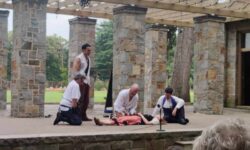[ccfic caption-text format="plaintext"]
By James Kinneen
Hometown Weekly Reporter
If you were to ask Phil Dorion for help with your photography, you would probably start by asking him about lenses, camera brands and photo manipulating software. This would be a terrible decision, as you would be committing one of the mistakes Dorion sees as being so prevalent in the modern era of photography: putting the technical above the aesthetic.
Dorion, a former corporate communications photographer, found that his day job encouraged this idea, as selling something is so dependent upon something’s aesthetic appeal. After becoming a traditional artist (in the sense that he began doing things like painting pastels), Dorion learned minimalism, and was more able to escape the constrained and targeted way of seeing things for the purpose of selling.
This brings us to Dorion’s landscape photographs, which are on display throughout the month of September at the Walpole Library. In these images, Dorion isn’t trying to sell anyone anything. Rather, he is trying to get a viewer “to either get something they associate in themselves out of the image, or feel something of what I was trying to express, like beauty, texture, or a sense of place.”
This idea, the “expression of subjective notions brought through objective aesthetics,” is known as equivalence, and is absolutely pivotal to Dorion’s process. In describing the concept, Dorion quoted American photographer Alfred Stieglitz.
“What is of greatest importance is to hold the moment, to record something so completely that those who see it will relive an equivalent of what has been expressed,” said Stieglitz. “It is only after I have created an equivalent of what has moved me that I can think about its significance.”
This idea is largely lost in modern photography, as we are constantly bombarded with images void of meaning or well-thought-out design; they’re just pictures.
“With all the software today, we can have all of this technically perfect stuff, but nothing really speaks of the artist, so this work is meditative for me. When I go out and go to shoot, I’ll go to a place five or six times, because I’m after a particular thing. A good photograph needs to have good design. That’s where a lot of the iPhone stuff out there all looks the same, because it doesn’t have good design.”
Looking to tap into the viewer’s emotions, Dorion spends a lot of time creating the images that, he hopes, will get his audience to look past the basic idea of what the object is, and to the idea of what the object could be, or what it could mean.
“For me, when I approach this, I’m not going out looking for photographs. I don’t make photographs or take photographs. I make images - images of ideas I have in my brain, feelings that I have in my brain,” he explains. “So I’ll go to these various places. I’ll sit down on a rock, I’ll feel the wind, I’ll look around and I have a process called Mushin, which comes from Zen and means ‘no mind.’ You learn how to get rid of the conceptualized idea of something and move to the perceptual, so in other words, a tree is a tree, but a tree can be a beacon of ancient wisdom when you think of how long they’ve been around. So when I’m out there, it’s about learning to see, being able to respond and not take it because it looks pretty, but to explore the subject.”
But it’s not like enough meditation is going to get you to the level of craftsmanship Dorion possesses. Because of his years of photography, he has a masterful understanding of high-level concepts like dynamic symmetry, can manipulate how your eye moves around an image (something photographers call saccade), and has been a master of Photoshop since the program’s second edition.
Still, it is his eye that separates him from others.
For the Walpole exhibit, outside of a few images from Colorado, every image was obtained within forty miles of his home. With places like the Norfolk Prison, Plum Island, and Neponset Street opposite the Sunoco Station represented, Dorion shows that if you’re able to see things, you don’t have to be in places of obvious natural beauty. However, the images are intentionally non-iconic, untitled and unlabeled so that the emotion they bring out becomes more important that the actual locations where they were taken.
To this end, a large section of the exhibit involves images of Bird Park. While many of Dorion’s images are available for purchase (and he gives photography lessons, if you’d like to learn), the Bird Park images are highly discounted because some of the proceeds are going to the park itself.
Phil Dorion’s images will remain in the Walpole Library during regular hours until the end of September, if you’d like to view them and see what they mean to you.























